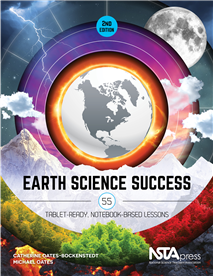Help Your Students Achieve Earth Science Success
By Carole Hayward
Posted on 2015-04-20
 NSTA Press authors Catherine Oates-Bockenstedt and Michael Oates, a daughter-father team, have collaborated on a second edition of Earth Science Success: 55 Tablet-Ready, Notebook-Based Lessons. The book provides a one-year curriculum with 55 classroom-proven lessons designed to follow the disciplinary core ideas for middle school Earth and space science from the Next Generation Science Standards (NGSS).
NSTA Press authors Catherine Oates-Bockenstedt and Michael Oates, a daughter-father team, have collaborated on a second edition of Earth Science Success: 55 Tablet-Ready, Notebook-Based Lessons. The book provides a one-year curriculum with 55 classroom-proven lessons designed to follow the disciplinary core ideas for middle school Earth and space science from the Next Generation Science Standards (NGSS).
Intended for teachers of grades 5-9, Earth Science Success emphasizes hands-on, sequential experiences through which students discover important science concepts lab by lab and develop critical-thinking skills. The first edition of the book focused more on the rationale for implementing the curriculum and the wisdom of using composition notebooks, this second edition focuses a special lens on the lessons themselves. The 55 lesson plans enable teachers to use electronic tablets, such as iPads, with best practice, field-tested methods.
Each of the labs is organized to follow a pattern of active involvement by students. Students are continually asked to search for evidence using a three-step discovery approach. The three steps are: anticipation, evidence collection, and analysis. Anticipation involves reflection on observations and a problem statement, recall of previous knowledge about the topic, discussion of misconceptions, and definition of concepts. Evidence collection includes hands-on laboratory investigation techniques. Analysis requires confirmation or rejection of results, reporting the findings, and drawing conclusions about the observations.
The book is organized into seven sections:
- Process of Science and Engineering Design
- Earth’s Place in the Solar System and the Universe
- Earth’s Surface Processes
- History of Planet Earth
- Earth’s Interior Systems
- Earth’s Weather
- Human Impacts on Earth Systems
The hope is that students will form good habits about testing and controlling all possible variables in their experiments whenever they are collecting evidence. They should be able to identify the manipulated, measured, and controlled variables in each experiment. Results should be reliable and valid. And students should set up controls, as a basis of comparison, so they can determine the actual charges in their data. This pattern of active involvement by students is followed throughout Earth Science Success.
The authors understand how busy a classroom science teacher is, and they know that successful strategies include those that save you time and promote skillful organization. Both composition notebooks and electronic tablets offer tremendous opportunities in this regard.
Why are notebooks, both electronic and nonelectronic, so valuable? One of the most important reasons is that students are able to organize, reflect upon, and achieve at higher levels. Students tend to have fewer missing assignments, and “no name” papers are a thing of the past. Tablets enable connections to internet research, word-processing capabilities, real-time data, and access to rich video vignettes to expand learning. The tablet and composition notebooks are also great resources to use at parent/teacher conferences.
This book is also available as an e-book.
The mission of NSTA is to promote excellence and innovation in science teaching and learning for all.
Follow NSTA
Disclaimer: The views expressed in this blog post are those of the author(s) and do not necessarily reflect the official position of the National Science Teaching Association (NSTA).


